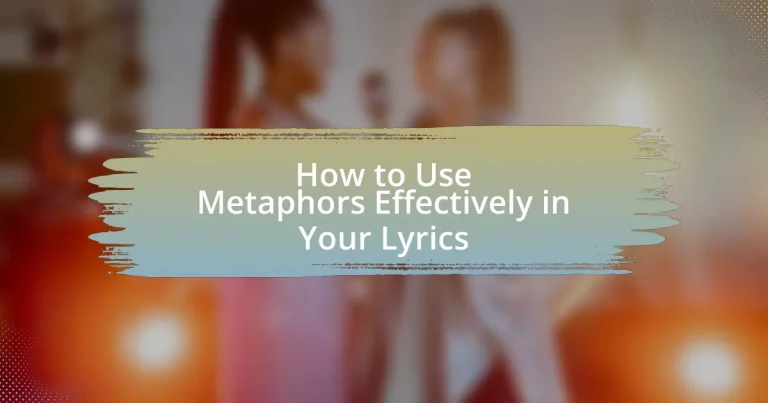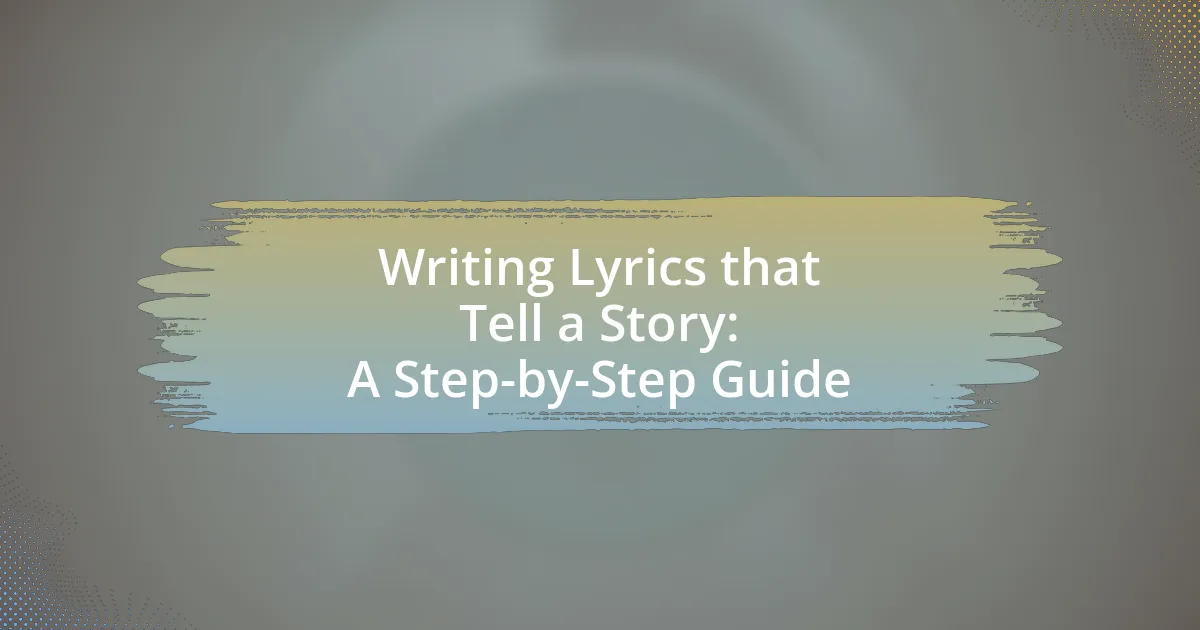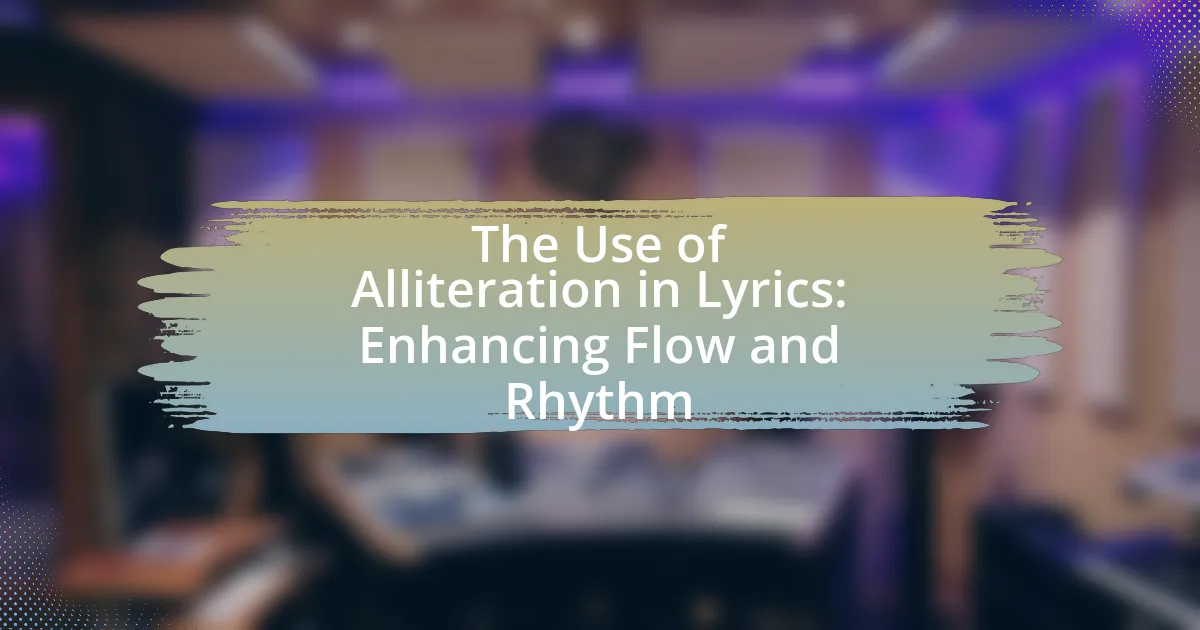Metaphors are essential figures of speech in songwriting that create implicit comparisons, enhancing emotional resonance and meaning in lyrics. This article explores the significance of metaphors, detailing how they evoke emotional responses, create vivid imagery, and deepen listener engagement. It categorizes different types of metaphors, such as direct, implied, and extended metaphors, and provides strategies for crafting effective metaphors that resonate with audiences. Additionally, it addresses common pitfalls to avoid, such as clichés and overcomplicated imagery, while offering best practices for integrating metaphors seamlessly into songwriting.
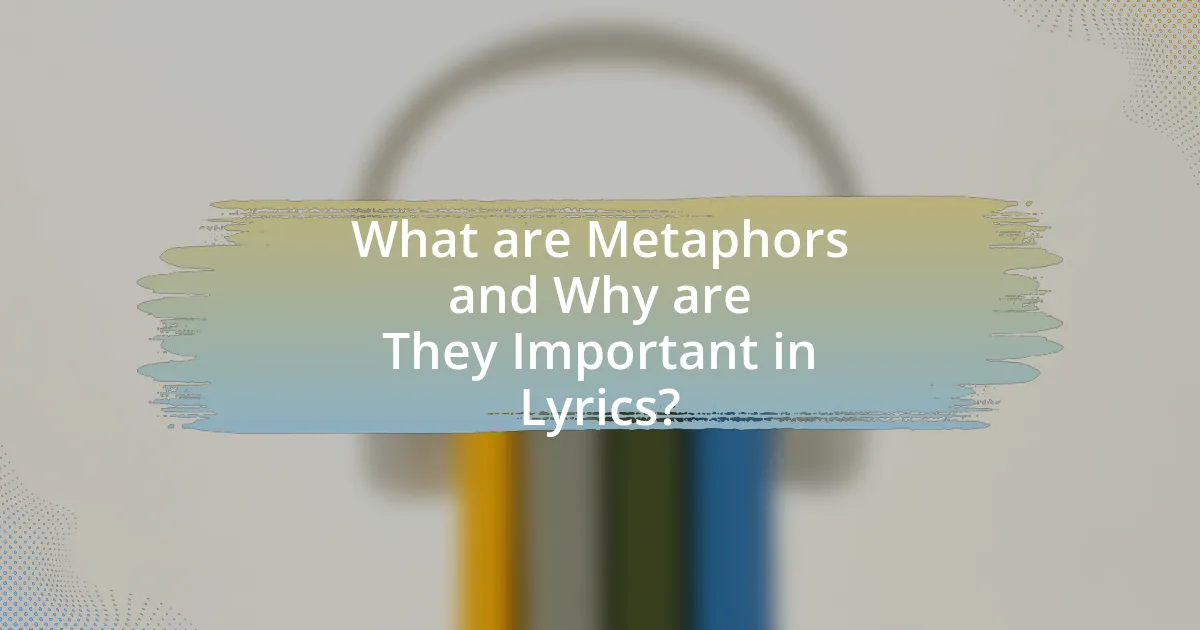
What are Metaphors and Why are They Important in Lyrics?
Metaphors are figures of speech that make implicit comparisons between two unrelated things, enhancing meaning and emotional resonance in lyrics. They are important in lyrics because they allow songwriters to convey complex emotions and ideas succinctly, creating vivid imagery that resonates with listeners. For example, Bob Dylan’s use of metaphors in songs like “Blowin’ in the Wind” deepens the thematic content, inviting listeners to explore profound social issues through relatable imagery. This technique not only enriches the lyrical experience but also fosters a deeper connection between the artist and the audience.
How do metaphors enhance the meaning of lyrics?
Metaphors enhance the meaning of lyrics by creating vivid imagery and emotional resonance that deepen the listener’s understanding. They allow songwriters to convey complex ideas and feelings in a relatable manner, making abstract concepts tangible. For instance, when a lyric compares love to a “burning fire,” it evokes strong emotions and visual associations, enriching the listener’s experience. Research in cognitive linguistics shows that metaphors shape our perceptions and can influence emotional responses, demonstrating their effectiveness in lyrical composition.
What emotional responses do metaphors evoke in listeners?
Metaphors evoke a range of emotional responses in listeners, including empathy, nostalgia, and inspiration. These emotional reactions occur because metaphors create vivid imagery and connections that resonate with personal experiences. For instance, a metaphor comparing love to a journey can evoke feelings of nostalgia as listeners reflect on their own relationships. Research by Lakoff and Johnson in “Metaphors We Live By” demonstrates that metaphors shape our understanding and emotional responses by framing concepts in relatable terms. This framing influences how listeners perceive and feel about the subject matter, enhancing the emotional depth of lyrics.
How can metaphors create vivid imagery in songwriting?
Metaphors create vivid imagery in songwriting by allowing songwriters to convey complex emotions and ideas through relatable comparisons. By equating one thing to another, metaphors evoke sensory experiences that paint a mental picture for the listener, enhancing emotional connection. For example, when a songwriter describes love as a “burning fire,” it not only suggests warmth but also intensity and potential pain, engaging the listener’s imagination. This technique is supported by research indicating that metaphorical language activates the brain’s sensory areas, making the imagery more impactful and memorable.
What types of metaphors can be used in lyrics?
Metaphors in lyrics can be categorized into several types, including direct metaphors, implied metaphors, extended metaphors, and mixed metaphors. Direct metaphors explicitly state that one thing is another, such as “Time is a thief,” while implied metaphors suggest a comparison without directly stating it, like “He sailed through life.” Extended metaphors develop a comparison over several lines or verses, providing depth, as seen in works like “The Road Not Taken” by Robert Frost. Mixed metaphors combine elements from different metaphors, which can create vivid imagery but may also lead to confusion if not executed carefully. These types of metaphors enhance lyrical expression by evoking emotions and painting vivid pictures in the listener’s mind.
What is the difference between direct and indirect metaphors?
Direct metaphors explicitly state that one thing is another, such as “Time is a thief,” while indirect metaphors imply the comparison without stating it outright, like saying “The thief crept in as the clock struck midnight.” The clarity of direct metaphors makes them straightforward, whereas indirect metaphors require interpretation, adding depth and nuance to the imagery.
How can extended metaphors be effectively utilized in a song?
Extended metaphors can be effectively utilized in a song by creating a cohesive theme that resonates throughout the lyrics. This technique allows songwriters to draw parallels between two seemingly unrelated concepts, enhancing emotional depth and listener engagement. For instance, in the song “Firework” by Katy Perry, the metaphor of a firework symbolizes personal empowerment and self-worth, which is consistently developed throughout the verses and chorus. This consistent imagery helps listeners connect with the message on a deeper level, making the metaphor memorable and impactful.
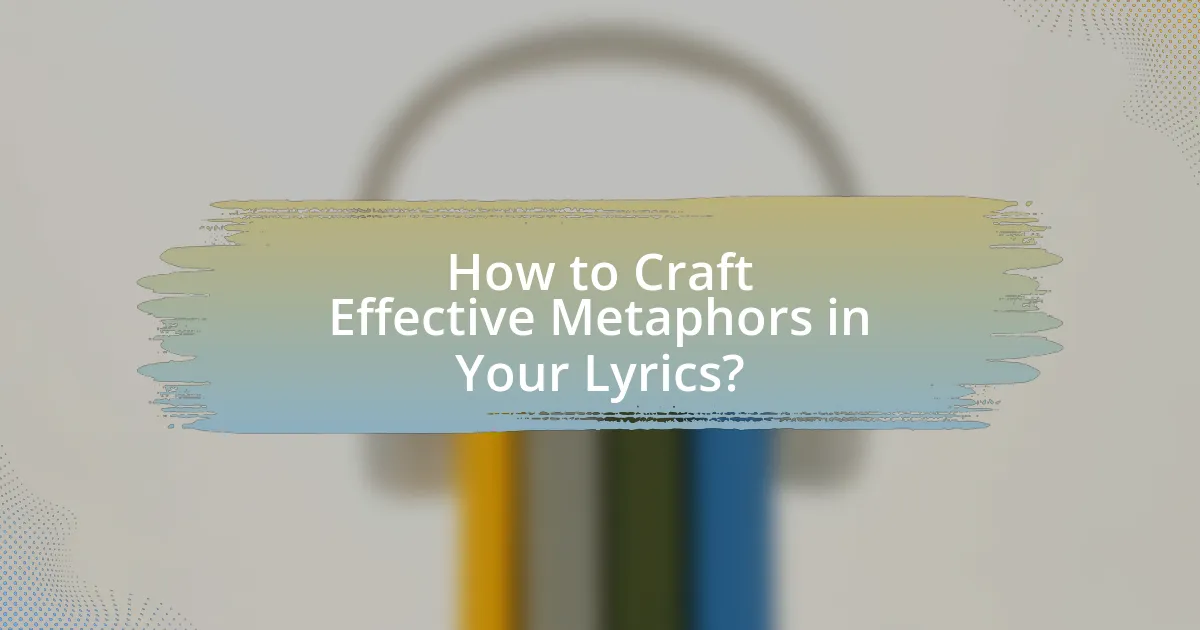
How to Craft Effective Metaphors in Your Lyrics?
To craft effective metaphors in your lyrics, focus on creating vivid imagery that resonates emotionally with your audience. Start by identifying a core theme or emotion you want to convey, then find relatable comparisons that enhance the meaning. For instance, if you are writing about love, you might compare it to a journey, illustrating the ups and downs through the metaphor of a winding road. This technique not only deepens the listener’s understanding but also makes the lyrics more memorable. Research shows that metaphors can enhance emotional engagement, as they allow listeners to visualize and connect with the message on a personal level.
What techniques can be used to develop strong metaphors?
To develop strong metaphors, one effective technique is to draw connections between seemingly unrelated concepts, allowing for deeper emotional resonance. This can be achieved by identifying shared qualities or experiences between the two subjects, which enhances the metaphor’s impact. For instance, comparing love to a journey can evoke feelings of adventure and uncertainty, making the metaphor relatable and vivid. Additionally, using sensory language to describe the metaphor can create a more immersive experience for the audience, as it engages multiple senses and evokes strong imagery. Research in cognitive linguistics supports this approach, indicating that metaphors shape our understanding and emotional responses, thereby reinforcing their effectiveness in communication.
How does personal experience influence metaphor creation?
Personal experience significantly influences metaphor creation by providing unique insights and emotional depth that shape the way individuals express abstract concepts. When individuals draw from their own life events, feelings, and observations, they create metaphors that resonate on a personal level, making them more relatable and impactful. For instance, a songwriter who has experienced heartbreak may use metaphors related to loss and emptiness, such as “a shattered mirror,” to convey complex emotions. This connection between personal experience and metaphor not only enhances the authenticity of the lyrics but also allows listeners to connect with the underlying sentiments, as evidenced by studies showing that emotionally charged metaphors are more memorable and effective in communication.
What role does word choice play in crafting metaphors?
Word choice is crucial in crafting metaphors as it determines the clarity, impact, and emotional resonance of the comparison being made. Specific words evoke particular images and feelings, allowing the metaphor to convey deeper meanings and connections. For instance, using “ocean” instead of “water” in a metaphor can evoke vastness and depth, enhancing the imagery and emotional weight. Research in cognitive linguistics shows that precise language can significantly influence how metaphors are perceived and understood, reinforcing the idea that careful selection of words is essential for effective metaphorical expression in lyrics.
How can you ensure your metaphors resonate with your audience?
To ensure your metaphors resonate with your audience, tailor them to the shared experiences and cultural references of that audience. This approach increases relatability and emotional impact, as metaphors grounded in familiar contexts are more easily understood and appreciated. Research indicates that effective communication relies on the audience’s ability to connect with the content; for instance, a study by the University of California found that metaphors linked to common life experiences enhance comprehension and retention. By using metaphors that reflect the audience’s realities, you create a stronger connection and enhance the overall effectiveness of your lyrics.
What strategies can help you connect metaphors to universal themes?
To connect metaphors to universal themes, one effective strategy is to identify shared human experiences that resonate across cultures, such as love, loss, or hope. By grounding metaphors in these common experiences, writers can create relatable imagery that evokes emotional responses. For instance, using the metaphor of a journey to represent personal growth taps into the universal theme of transformation, making the lyrics more impactful. This approach is supported by research in cognitive linguistics, which suggests that metaphors shape our understanding of abstract concepts through familiar experiences, thereby enhancing the emotional depth of the lyrics.
How can feedback from others improve your metaphor usage?
Feedback from others can significantly enhance metaphor usage by providing diverse perspectives that reveal how metaphors are interpreted. When individuals receive constructive criticism or suggestions, they can identify which metaphors resonate with their audience and which may be unclear or ineffective. Research indicates that collaborative feedback fosters creativity and refines language skills, as seen in studies on peer review processes in writing workshops. This process allows lyricists to adjust their metaphors for clarity and emotional impact, ultimately leading to more powerful and relatable lyrics.
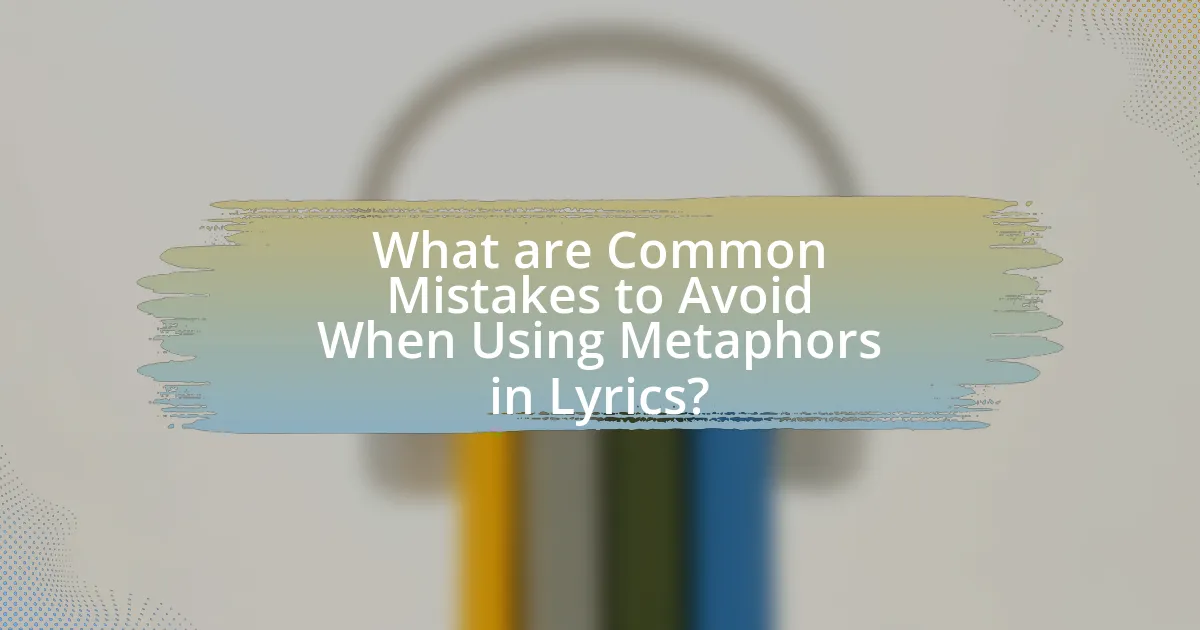
What are Common Mistakes to Avoid When Using Metaphors in Lyrics?
Common mistakes to avoid when using metaphors in lyrics include overcomplicating the imagery, using clichés, and lacking clarity. Overcomplicating metaphors can confuse listeners, making it difficult for them to grasp the intended meaning. For instance, a metaphor that is too abstract may alienate the audience rather than resonate with them. Using clichés, such as “time is a thief,” can make lyrics feel unoriginal and uninspired, diminishing their impact. Additionally, lacking clarity in metaphors can lead to misinterpretation; if the metaphor does not clearly relate to the song’s theme, it can create disconnect. These mistakes can hinder the effectiveness of metaphors in conveying emotions and messages in lyrics.
What pitfalls should you be aware of when writing metaphors?
When writing metaphors, one should be aware of the pitfalls of overcomplication, ambiguity, and cliché. Overcomplication occurs when metaphors become too intricate, making them difficult for the audience to understand; for instance, a metaphor that requires extensive explanation can lose its impact. Ambiguity arises when a metaphor is not clear, leading to multiple interpretations that can confuse the listener; clarity is essential for effective communication. Cliché metaphors, which are overused and lack originality, can diminish the emotional resonance of lyrics, as they fail to engage the audience’s imagination. These pitfalls can hinder the effectiveness of metaphors in conveying meaning and emotion in lyrics.
How can clichés undermine the effectiveness of your metaphors?
Clichés undermine the effectiveness of metaphors by diluting their originality and impact. When metaphors rely on overused phrases, they fail to evoke fresh imagery or emotions, making them less memorable. For instance, using “time is money” as a metaphor lacks the creativity needed to engage an audience, as it has been widely adopted and thus loses its potency. Research indicates that unique and vivid metaphors enhance listener engagement and emotional resonance, while clichés can lead to disengagement and a lack of connection with the audience.
What happens when metaphors are too complex or obscure?
When metaphors are too complex or obscure, they can confuse the audience and obscure the intended message. This confusion arises because listeners may struggle to grasp the meaning, leading to misinterpretation or disengagement from the lyrics. Research indicates that clarity in communication enhances audience connection; for instance, a study by the University of California found that clear metaphors significantly improve comprehension and emotional resonance in songwriting. Therefore, overly intricate metaphors can hinder effective communication in lyrics, ultimately diminishing their impact.
How can you refine your metaphors for clarity and impact?
To refine your metaphors for clarity and impact, focus on specificity and relevance to your audience. Specific metaphors resonate more effectively because they create vivid imagery and relatable connections. For instance, instead of saying “life is a journey,” you might say “life is a winding road with unexpected detours,” which provides a clearer visual and emotional context. Additionally, ensure that the metaphor aligns with the overall theme of your lyrics, enhancing the message rather than distracting from it. Research indicates that effective metaphors can increase listener engagement and emotional response, as demonstrated in studies on lyrical analysis and audience perception.
What techniques can help simplify complex metaphors?
Techniques that can help simplify complex metaphors include using concrete imagery, breaking down the metaphor into relatable components, and employing familiar cultural references. Concrete imagery allows the audience to visualize the metaphor more easily, while breaking it down into relatable components helps clarify its meaning by connecting it to everyday experiences. Familiar cultural references can anchor the metaphor in a shared understanding, making it more accessible. For instance, using a metaphor like “life is a journey” simplifies the concept by relating it to a common experience, thus enhancing comprehension.
How can you test the effectiveness of your metaphors before finalizing lyrics?
To test the effectiveness of your metaphors before finalizing lyrics, you can gather feedback from a diverse audience. This involves sharing your lyrics with individuals who have varying levels of familiarity with your music style, as their interpretations can reveal how well the metaphors resonate. Research indicates that metaphors enhance understanding and emotional engagement when they are relatable and clear; thus, testing them in this way can provide insights into their impact. Additionally, analyzing listener reactions through surveys or focus groups can quantify the effectiveness of the metaphors, allowing you to refine them based on concrete feedback.
What are some best practices for using metaphors in your lyrics?
Best practices for using metaphors in lyrics include ensuring clarity, maintaining relevance, and evoking emotion. Clarity is essential; metaphors should be easily understood by the audience to enhance the message rather than confuse it. Relevance ensures that the metaphor aligns with the song’s theme and resonates with listeners, making the lyrics more impactful. Evoking emotion through metaphors can create a deeper connection with the audience, as metaphors often convey complex feelings in relatable terms. For instance, Bob Dylan’s use of metaphors in “Blowin’ in the Wind” effectively communicates profound social messages while remaining accessible.
How can you balance metaphor use with straightforward language?
To balance metaphor use with straightforward language, incorporate metaphors selectively and ensure they enhance clarity rather than obscure meaning. Effective lyricists often use metaphors to evoke emotions or paint vivid imagery while maintaining a clear narrative. For instance, using a metaphor like “life is a journey” can convey complexity while remaining relatable. Research indicates that clear communication, even with figurative language, improves listener engagement and understanding, as shown in studies on cognitive processing in music. Thus, the strategic use of metaphors alongside clear language can create impactful and accessible lyrics.
What tips can help you integrate metaphors seamlessly into your songwriting process?
To integrate metaphors seamlessly into your songwriting process, focus on identifying relatable themes and emotions that resonate with your audience. Start by brainstorming personal experiences or universal concepts that evoke strong imagery. For instance, using nature as a metaphor for love can create vivid connections, such as comparing a relationship to a blooming flower. Additionally, practice weaving metaphors into your lyrics by writing them alongside your main ideas, ensuring they enhance rather than overshadow the message. This technique is supported by studies in cognitive linguistics, which show that metaphors can deepen emotional engagement in music, making the lyrics more impactful.
